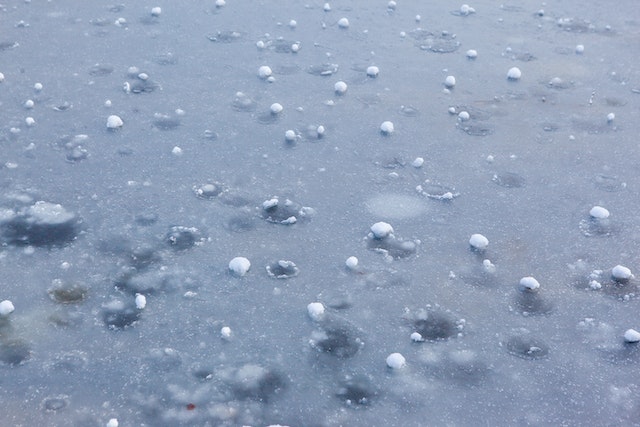
What is the difference between snowflakes and hail? Snowflakes are made up of ice crystals and hail is a frozen raindrop.
Hail are frozen raindrops. They are generally between 5 mm and 15 cm in diameter. Hail is not as common as snow and can only form in a thunderstorm. For hail to form there needs to be a cumulonimbus cloud as those are the only clouds that reach high enough. A thunderstorm forms when warm moist air is lifted up into an area of cold air. As the warm air rises, it starts to cool and it condenses. Warm air holds a lot of water vapor, which is water in its gas phase. As the warm air cools down, the water vapor turns back into water. These water droplets fall out of the cloud and the cold air now sinks back down again. When it gets to the bottom, the whole process repeats itself.
Hail forms when the rising air carries the raindrops above the freezing level of the atmosphere. The pressure difference between the hot air and the cool air produces strong winds that lift the raindrops high into the atmosphere and they become supercooled. Once the raindrop is supercooled, it has a super cooled vapor that surrounds it. When other raindrops come into contact with this frozen vapor, they freeze instantly and the frozen raindrop gradually gets bigger. The hailstones are so cold they have a sticky outer surface and they keep growing. The wind keeps pushing them up until they become too heavy to lift and then they fall as hail. Most of the time, the hailstones melt as they fall through the lower levels of the cloud where the air is warmer and return to the cycle. If the stones are particularly large, they will fall through the cloud and there is the hail.
Snowflakes form in clouds that have a lot of moisture. The rising water vapor reaches the freezing point and is supercooled. This means it freezes instantly without first turning to water. If it became water first, it would freeze as ice, but instead, the water vapor freezes forming ice crystals. These ice crystals are usually about 10 micrometers in diameter. Once one ice crystal has formed, it sticks to other ice crystals and the snowflake starts to grow. The type of cold and the amount of water, along with a whole host of other variables, can change the way the flakes come together and their size and shape. A snowflake has roughly 10,000,000,000,000,000,000 water molecules in it. I don’t know how they counted that. The snowflakes grow until they are too heavy to stay aloft and then they fall.
Both hail and snow can cause problems. Hail is dangerous because of its size and the speed with which it falls out of the sky. Large hailstones can reach speeds of up to 160 km/h and they can destroy crops and buildings, as well as being lethal. Their terminal velocity is determined by their size, their shape, and the amount of other hail or rain in the air that they fall through. A hail storm can completely destroy a field of crops. Famers can take out hail insurance in places that are prone to hailstorms. Hail causes about $850 million of damage in the US alone every year. Hail can also cause injury and death. If you are stuck outside in a hailstorm, cover your head with something. And don’t hide under a tree because hail comes from thunderstorms.
Snow can also cause damage and be dangerous, but the danger doesn’t come from a single snowflake, more the accumulation of snow. Different types of snow have different mass, but on average, snow weighs about 22kg per square meter. That is enough to break roofs and destroy buildings. Overall, snow is far more deadly than hail, simply because there is far more of it. Over 1,800 people a year die because of driving in snowy conditions in the USA. Snow also kills through avalanches. The runoff from melting snow can also be very dangerous.
So, snowflakes are formed when water vapor freezes and then sticks to other frozen ice crystals. Hail forms when the wind blows rain up into the atmosphere and it freezes.
https://en.wikipedia.org/wiki/Hail
https://www.abc.net.au/science/articles/2008/09/18/2367819.htm
http://www.differencebetween.net/science/nature/difference-between-snow-and-hail/
https://en.wikipedia.org/wiki/Snow
